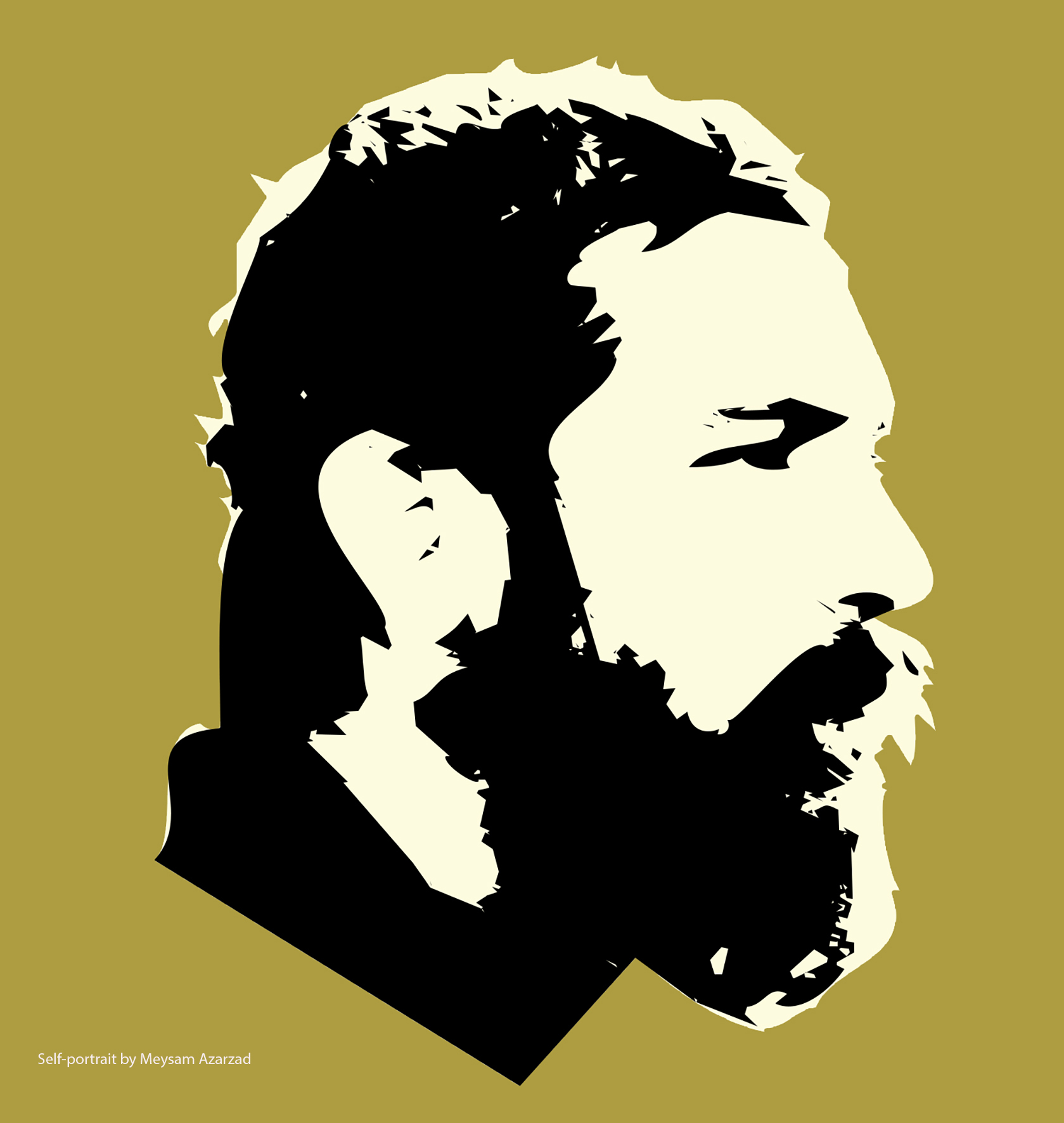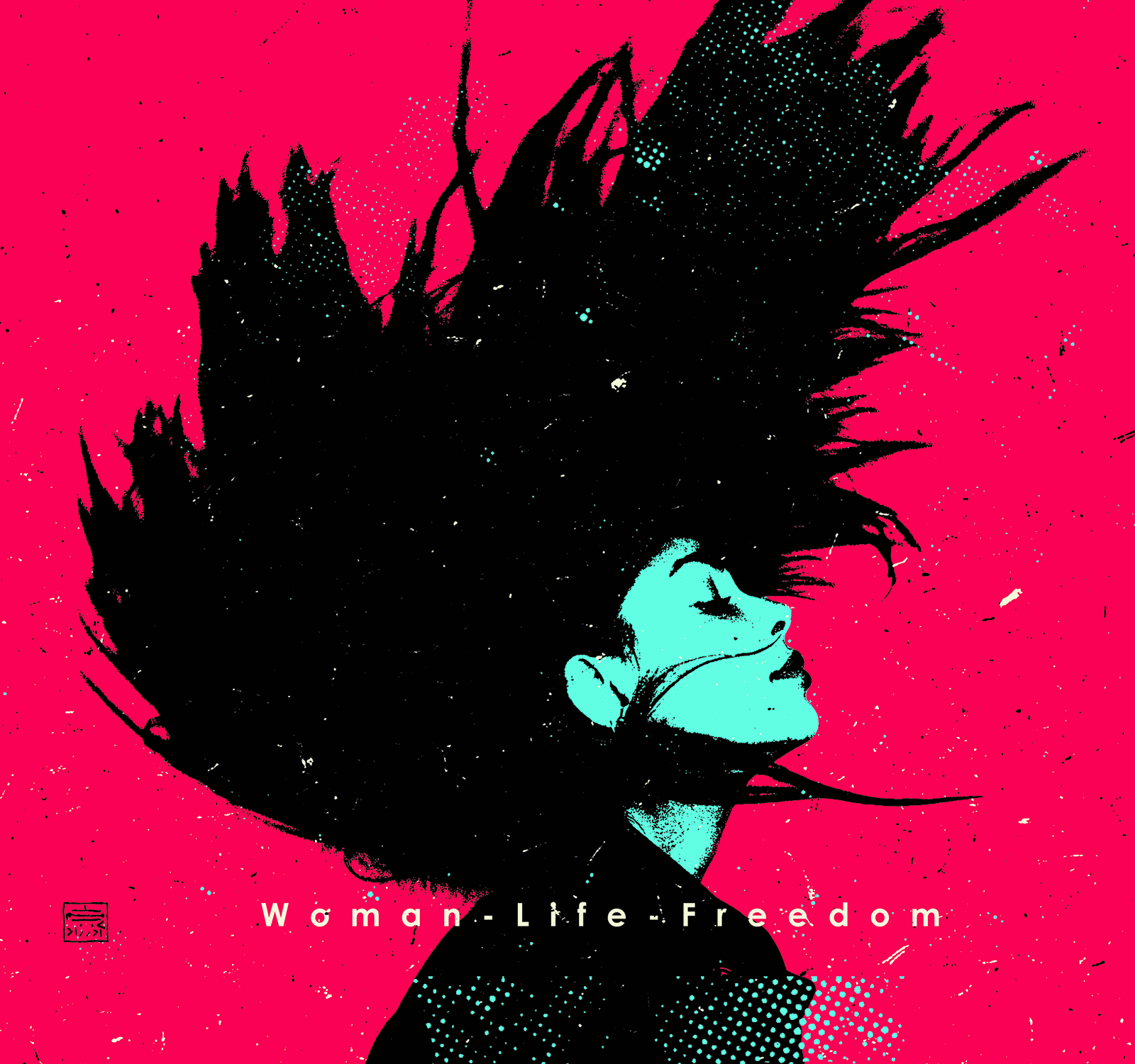A Collection of Meysam’s work will be opening at the Dedee Shattuck Gallery on September 22nd at 6pm. Professor Karimi will speak at 6:30. Gallery will be open September 23, 24, 30 and 31 from 12-5pm. Please RSVP on Facebook or Eventbrite.
When the tragic demise of 22-year- old Mahsa Jina Amini on September 16, 2022, at the hands of Iran’s “morality police”, became public knowledge, it was her haunting image that imprinted itself on the world’s collective conscience. As it permeated the media, the photograph – showing Amini connected to ventilators for her “crime” of a loosely-worn scarf – ignited widespread shock. This stark visual narrative was so potent that it drew the attention of Iranian state authorities, leading to the arrest and incarceration of its photographer, journalist Niloofar Hamedi. Not to be silenced, other Iranian artists responded with art reproductions of the heart-rending image, each invoking feelings of grief and resistance.

In the past four decades artists in Iran have navigated around state censorship with allegory, metaphor, and understated resistance. However, following the uprising sparked by Amini’s death, a bold and defiant spirit has permeated the activist art produced in Iran. Meysam Azarzad, an artist once held in Tehran’s notorious Evin political prison, has been a leading voice in this evolving activist art scene since the onset of the uprising. His poignant creations spotlight the portrait of Amini as well as those of many others who were murdered, tortured, or imprisoned during the uprising. Azarzad’s pieces, originally crafted for his widely-followed Instagram page, are now on display in a solo exhibition at the Dedee Shattuck Gallery in Westport, MA, curated by Pamela Karimi and Merri Cyr. These works have since become emblematic of the uprising, now known as “Woman, Life, Freedom.”

Meysam Azarzad masterfully intertwines ancient poetic verses with the bold visages of young Iranians on Instagram. His pieces spotlight undaunted men and women, seamlessly paired with modified verses from the 11th-century nationalistic poet, Abolghassem Ferdowsi’s “Shahnameh” or “Book of Kings”.
This melding of language and imagery echoes an age-old Iranian tradition where visual art resonated deeply with poetry and prose, emphasizing that art from this region was seldom just a singular visual experience. The exhibition not only commemorates Mahsa Amini’s tragic end but also lauds Azarzad’s dedication to preserving the events and heroes of the uprising. His visual narrative ensures that despite the risks of erasure in the digital age, the revolution’s heroes – whether fallen, imprisoned, or tortured – remain etched in the nation’s memory.
The exhibition not only commemorates Mahsa Amini’s tragic end but also lauds Azarzad’s dedication to preserving the events and heroes of the uprising. His visual narrative ensures that despite the risks of erasure in the digital age, the revolution’s heroes – whether fallen, imprisoned, or tortured – remain etched in the nation’s memory.
 As you explore this exhibition, we hope you recognize the significance of what is considered by many as the world’s first Feminist revolution. Furthermore, we hope you acknowledge the pivotal role Middle Eastern women have taken in their pursuit of democracy.
As you explore this exhibition, we hope you recognize the significance of what is considered by many as the world’s first Feminist revolution. Furthermore, we hope you acknowledge the pivotal role Middle Eastern women have taken in their pursuit of democracy.
Pamela Karimi is a Professor of History of Art and Architecture at the University of Massachusetts Dartmouth. She is the author of Domesticity and Consumer Culture in Iran and Alternative Iran: Contemporary Art and Critical Spatial Practice. In the wake of the “Woman, Life, Freedom” uprising, Karimi has penned numerous articles and delivered lectures, highlighting the pivotal role of art in the movement. Since joining the University of Massachusetts in 2009, she has curated various exhibitions. Of particular note is this solo exhibition at Deedee Shattuck Gallery, featuring Meysam Azarzad’s activist art. The exhibition draws from Karimi’s ongoing research into the intersections of art and activism in Iran and marks the anniversary of the uprising in September 2022.
Meysam Azarzad was born in 1985 in Tehran, Iran. At the age of fifteen, he embarked on his professional illustration journey, collaborating with multiple publications within Tehran. Later, he chose to study graphic design in college. For seven years, Azarzad delved deeply into press illustrations, caricature design, and writing. His passion for animation subsequently steered him to professional roles in character and background design at various animation studios in Tehran. This progression marked the onset of a 15-year commitment to not only editing and scriptwriting but also directing and producing across diverse platforms such as cinema, video art, music videos, video advertisements, and motion graphics.
An artist with a broad spectrum, Azarzad has crafted and delivered over 200 advertising and video art projects. He has penned and directed two medium-length films, two short narrative films, and several documentaries. Furthermore, he has imparted his knowledge of motion graphics by teaching in Tehran. Demonstrating versatility in his craft, Azarzad has participated in countless group exhibitions showcasing caricature and illustration, both within Iran and on the international stage. His unparalleled skills have garnered him a plethora of awards in caricature, graphic design, animation, and video art from festivals both at home and abroad.
In 2009, due to his participation in the Green Movement protests, Azarzad endured incarceration at Evin, Tehran’s infamous political detention center. Today, while maintaining his activist stance expressed through art, he thrives as a freelancer spanning various media forms.
For more information about this exhibition, please see the interview with Professor Pamela Karimi [click here]











